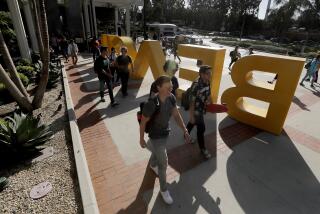Judge halts Trump’s NIH cuts that support medical research after California and 21 states sue

- Share via
- A judge temporarily stopped the Trump administration from making billions in NIH medical research cuts after California and 21 states sued.
- The NIH says the cuts are necessary and target overhead. University leaders say the money is essential to operations.
- The ruling applies to the 22 states who brought the suit, which alleged the cuts will lead to layoffs, clinical trial suspensions and lab closures.
A federal judge in Massachusetts on Monday blocked the Trump administration from making billions of dollars in NIH funding cuts hours after California and 21 other Democratic-run states sued, saying the action would hurt Americans who benefit from life-saving medical discoveries into cancer, diabetes and other major diseases.
In granting a temporary restraining order, U.S. District Judge Angel Kelley suggested that she agreed, for the time being, with arguments in the lawsuit saying the drastic cuts would cause irreparable harm to medical research at the University of California, California State University and other institutions.
The states, backed by university presidents, alleged in the suit that a $4 billion loss of funding would “result in layoffs, suspension of clinical trials, disruption of ongoing research programs, and laboratory closures.”
The halt only applies to the 22 states — including Arizona, Michigan, New York, Hawaii and Massachusetts — that sued. No states with Republican governors joined.
Kelley’s ruling is not final but applies as the case continues in court. The judge ordered the states to report back within 24 hours on the status of their funding and follow up every two weeks to verify the cash-flow. The next hearing is scheduled for Feb. 21.
In a statement, California Atty. Gen. Rob Bonta said he was pleased with the court decision. “My fellow attorneys general and I will be closely monitoring to ensure that the Trump Administration follows the court’s order,” he said.
UC officials said in a statement that they were “grateful for the judge’s order.... The University of California is committed to working with the new administration to ensure taxpayer dollars are well spent on innovations and lifesaving research.”
UC is a major recipient of NIH research funding. It is not party to the suit but filed a declaration in support of the case.
The NIH policy announced Friday night reduces more than half of its spending for overhead costs tied to research grants. Called “indirect funding,” the money pays for research supplies, building maintenance, utilities, support staff and other costs.
The lawsuit argues the NIH cuts run counter to federal law. It cites part of a 2018 appropriations act that prohibits the NIH from making unilateral “deviations from negotiated rates” in its overhead funding to institutions. That portion of the budgetary rule “has remained in effect through every appropriations law governing HHS to this day,” the suit says, referring to the Department of Health and Human Services under which NIH operates. It also cites the Administrative Procedure Act, passed in 1946, regarding changes to federal agency rules.
Drastic cuts to National Institutes of Health ‘indirect funds’ for medical research has prompted deep concerns at UC over how to continue studies into ‘life-saving treatments.’
The Trump administration is “violating the law” and wants to “eviscerate funding for medical research,” Bonta said of the suit, which was filed against the Department of Health and Human Services and the NIH.
The NIH directed The Times to the Department of Health and Human Services for comment about the suit. An HHS official declined to comment because on pending litigation and did not reply to a follow-up question about the judge’s order.
The NIH awards more than $35 billion in annual funding for a wide range of medical research on Alzheimer’s, Parkinson’s, heart disease, strokes and studies on military veterans and trauma, among other health conditions.
California universities are among the largest awardees of NIH grants in the nation and UC receives more than half of the NIH distributions in the state. Stanford, Caltech, USC and CSU also receive significant research grants.
What the NIH cuts target
Beginning Monday, NIH-sponsored indirect funding was to be capped at 15% of grants, down from the 57% that many UCLA research projects receive and the 64% given at UC San Francisco, which has the highest rate in the UC system.
California students sue Education Dept. over fears of Musk’s access to loan data as congressional members hold D.C. protest.
The new policy would affect grants supporting ongoing research and new ones.
In announcing the cuts, the NIH implied on a social media post and on its website that universities with large endowments were spending too much taxpayer money on overhead costs.
A graphic posted to the NIH X account showed the multibillion-dollar endowments of Harvard, Yale and Johns Hopkins next to their indirect funding rates. Harvard’s was the highest at 69%. As a comparison, NIH cited private foundations, including the Chan Zuckerberg Initiative and the Gates Foundation, saying their overhead costs are 15% or lower.
“The United States should have the best medical research in the world,” the NIH said in guidance posted to its website. “It is accordingly vital to ensure that as many funds as possible go towards direct scientific research costs rather than administrative overhead.”
In an email to The Times Monday, HHS spokesman Andrew G. Nixon said “most of these higher education institutions already have endowments worth billions of dollars.” He also said the department had authority to make universities pay back “the excess overhead they have previously received” but decided to not do so.
The department will “continue to assess” the payback “policy choice and whether it is in the best interest of the American taxpayer” the email said.
Why researchers say the funds are essential
University leaders and medical researchers say the money, despite being labeled “indirect funding,” is essential to their work and pays to keep lifesaving science going — from ensuring the proper storage of biological samples to keeping alive animals for medical trials.
In an email to UC researchers Monday, Katherine S. Newman, UC system provost and executive vice president for academic affairs, elaborated on how the funding is used.
She said indirect money pays for “personnel who assure the safety of adults and children enrolling in clinical trials” and the ethics teams working on trials. Budgets, she wrote, are “carefully audited.” Newman also noted that the reductions would “disrupt a critical relationship to the pharmaceutical and device industry partners who rely on our independent research and clinical trials to establish the efficacy of emerging treatments.”
The lawsuit echoes such concerns.
“In order to conduct research, a university needs buildings, and needs to maintain those buildings and supply them with heat and electricity,” the suit says. “A university also needs the infrastructure necessary to comply with legal, regulatory and reporting requirements. These facilities costs cannot be attributed to any particular research project, but are still necessary for any research to occur.”
The lawsuit said university administrative support, including clerical staff, IT support, cybersecurity and data servers, “help make research possible without being attributable to any specific grant or project.”
The funding rates are negotiated in agreements between the government and universities, the suit says, but have now been unilaterally changed.
“No statute allows NIH to unilaterally alter all current grants retroactively,” the filing 0. “No such power was conveyed by Congress here. Indeed, Congress has explicitly limited the NIH’s authority to modify indirect cost rates retroactively.”
The suit adds that the Department of Health and Human Services also has its own regulations that bar the NIH from making “indiscriminate changes” to the grants. The suit alleges that the NIH has “acted beyond its statutory authority.”
What’s at risk in California
The NIH provided $2.6 billion of UC’s $4.2 billion in federal awards last year, with its San Francisco, San Diego and Los Angeles campuses receiving the bulk of the funding.
Stanford was awarded $613 million in the same period. USC took in more than $356 million in NIH funds last year. At CSU’s 23 campuses, the NIH awards totaled $158 million last year. CalTech received more than $62 million.
UC President Michael Drake said Monday the cuts, if realized, would be a “devastating blow” and the university is “ready to fight.”
“Like scores of institutions across the country, the University of California has relied on NIH grants to pursue life-saving research that benefits Americans nationwide,” Drake said. “Cuts of this magnitude would deal a devastating blow to our country’s research and innovation enterprise, undermine our global competitiveness, and, if allowed to go forward, will ultimately delay or derail progress toward treatment and cures for many of the most serious diseases that plague us today.”
“This is not only an attack on science, but on America’s health writ large,” Drake said.
In a statement, USC officials said the changes placed its medical research “in jeopardy” and that “we are working closely with partner organizations to address this evolving environment so that we continue our work on behalf of the public good.”
Jason Maymon, a CSU spokesman, said in a statement that the cuts threaten “the future of student innovation and scientific progress.”
“Federal grant funding is vital to the CSU’s teaching and research mission, which addresses some of society’s most urgent challenges in healthcare, agriculture, water, fire prevention and cybersecurity,” Maymon said.
In a statement Saturday, Stanford leaders said the cuts would amount to $160 million annually at the university, affecting the “construction of laboratory space, the purchase and maintenance of scientific tools, and research computing.”
“Indirect costs are the way the government invests in research infrastructure for the nation and are vital to our research activities,” said a campus message signed by Provost Jenny Martinez, medical school dean Dr. Lloyd Minor and Vice Provost and Dean of Research David Studdert.
More to Read
Sign up for Essential California
The most important California stories and recommendations in your inbox every morning.
You may occasionally receive promotional content from the Los Angeles Times.













